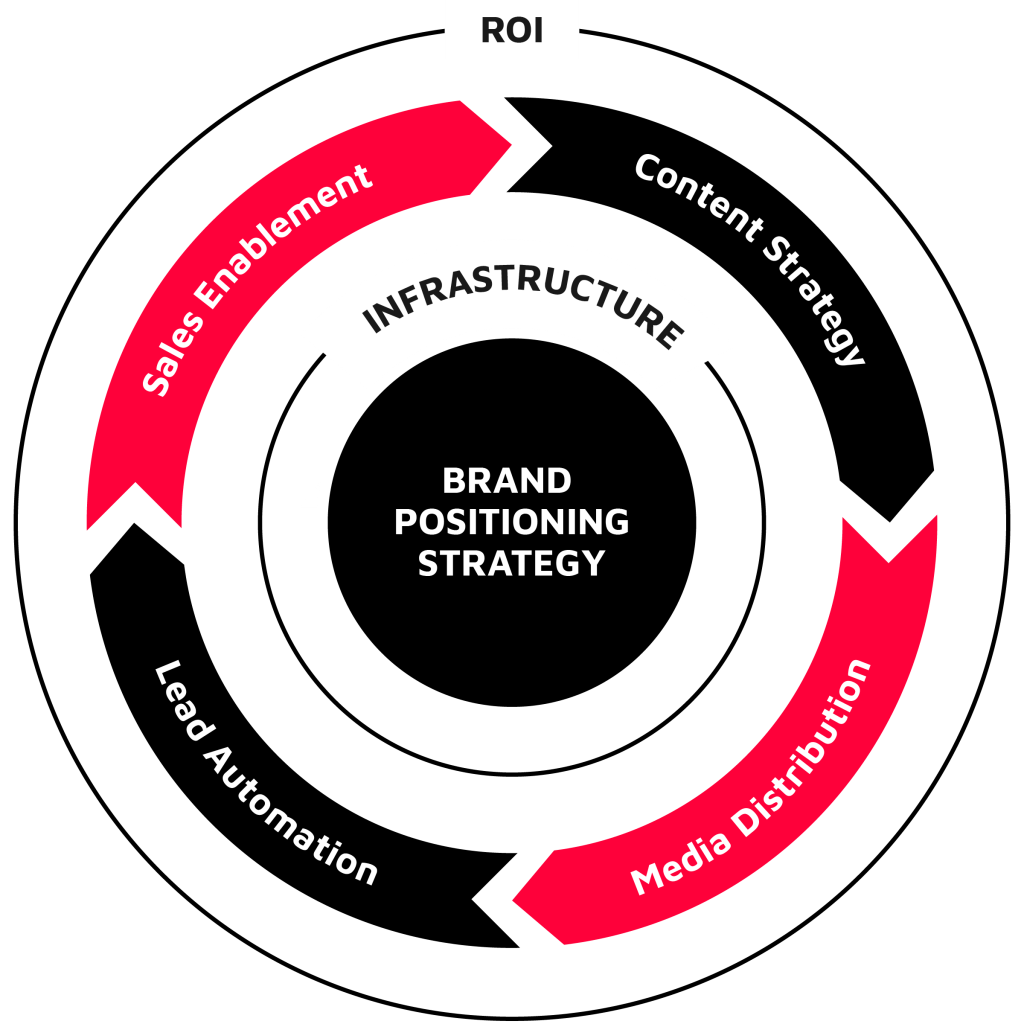Debunking the “magic bullet” marketing myth with actionable marketing strategies for startups seeking sustainable growth.

B2B startup founders are constantly bombarded with tales of overnight success, the allure of the magic bullet in marketing is hard to resist. This myth seduces us with promises of rapid growth and effortless wins, the kind we’re all hungry for. But this leads many down a path of endless guesswork. Without clear marketing strategies, founders find themselves chasing shadows, hoping for that one viral campaign that will skyrocket their startup to fame. But here’s the unvarnished truth: sustainable growth isn’t conjured through marketing miracles but forged through strategic rigor and a deep understanding of your market.
Let’s peel back the layers of myth to reveal the core of real success—a systematic, strategy-driven approach that aligns your startup’s unique value with the needs of your target audience.
Dispelling the Magic Bullet Myth, and Pivoting to B2B Early-Stage Startup Marketing Strategies
Founders often fall prey to the allure of supposed quick fixes in marketing—a belief that one grand gesture can lead to instant success. This approach overlooks the complexity and nuance of effective marketing strategies for startups.
Consider these common missteps:
- Over-reliance on Single Marketing Channels: Startups may pour their hopes into one newsletter or single-channel social media marketing, expecting it to significantly move the needle on engagement or sales. Without a startup marketing strategy to consistently engage and understand the audience, these efforts seldom yield meaningful results.
- Misguided Paid Advertising Choices: Many startups view paid advertising (such as Google Ads, LinkedIn or Facebook) as a catch-all solution and start with high hopes. However, without a solid marketing strategy, campaigns tend to fail. When this happens, companies will blame the platform (or the ads manager) and hastily pull their investment, never realizing that lack of strategy was the true culprit. We see it all the time, and it leaves a lot of money on the table!
- Chasing Trends Without Purpose: Jumping on the latest marketing trend or tool can seem like an easy win. Yet, without aligning these efforts with the startup’s overall business goals and audience needs, they can lead to wasted resources and a diluted brand message.
- Missing the Forest for the Trees: All your marketing initiatives play a vital role in moving people along the pipeline, and it’s important to understand how they function and what success means. Search Engine Optimization is an example of where people tend to forget this. They’ll focus on particular metrics or a single keyword at the expense of the bigger picture. And this often leads them astray. Stay clear on your priorities using your strategy as your blueprint.
- Neglecting the Customer Journey: Assuming a single touchpoint can convert leads into customers ignores the complexity of the customer journey. A strategy that guides potential customers through each stage of discovery, consideration, and decision is crucial for long-term engagement and conversion.
In each of these scenarios, the underlying issue isn’t the tactic, but the absence of a cohesive, strategic approach that ties marketing efforts to the startup’s unique objectives and market. Imagine banking everything on one newsletter or a lone social media blitz, expecting a flood of engagement or sales, only to hear crickets. Diving in without nailing down your messaging or knowing the ins and outs of a channel can leave you high and dry, blaming everything but the lack of a real plan. It’s the strategic, step-by-step engagement that turns curious clicks into loyal customers. The real magic? It’s not in one-off wonders but in weaving a startup marketing strategy that threads through every marketing move you make, building a growth story that’s not just sustainable but also true to your startup’s mission and market.
The Power of Having a Plan: Marketing Strategies Based on Research
Marketing strategies for startups boil down to choices. What are the decisions you make, and how do you make them? Some people use what we call the “throwing spaghetti on the wall” method (ie: guessing and seeing what works). This is about as effective as a fortune cookie, but much more expensive. Though every once in a while a brand will stumble on a jackpot, we recommend against this approach.
B2B startup strategy work is about creating a guide to good decision-making, simply put. Such a plan acts as your north star, illuminating the path through the noisy marketing clutter and aligning your efforts with your audience, and your goals.
Let’s break down the essential elements of a strategic marketing plan and the transformative impact of a well-executed go-to-market (GTM) strategy.
The Cornerstones of a Strategic Marketing Plan:
Market Research:
The foundation of any GTM strategy is robust market research. It’s about peeling back the layers of your market to understand the dynamics at play, the pain points of your potential customers, and the opportunities that lie untapped. This isn’t surface-level knowledge but a deep dive into what makes your market tick, including trends, growth potential, and customer behaviors.
Competitive Analysis:
A detailed analysis of your competitors helps you identify not just their strengths and weaknesses but also the gaps in their approach that your startup can exploit. This insight informs your positioning and messaging, helping you carve out a unique niche in the market.
Crafting Value Propositions:
With a clear understanding of your market and competition (we break these steps down in more detail further down in this article), the next step is to define your value propositions. These are the pillars of your marketing strategy, articulating why customers should choose you over anyone else. A compelling value proposition is rooted in a deep understanding of your ideal customer profile (ICP), tailored to address their specific needs and pain points.
Why a GTM Strategy is Your Blueprint for Success:
A go-to-market strategy is your startup’s blueprint for success. It’s how you translate the insights from your market research and competitive analysis into actionable strategies that resonate with your target audience. This blueprint guides your tactical decisions, ensuring they are not scattered shots in the dark but deliberate moves that drive you closer to your goals.
Your GTM strategy is what allows you to move with confidence in the B2B arena, making informed choices about the channels you activate, the messages you amplify, and the relationships you nurture. It’s the strategic underpinning that ensures your marketing efforts are coherent, targeted, and ultimately, effective.
By anchoring your marketing initiatives in a solid GTM strategy, you empower your startup to navigate the complexities of the B2B landscape with precision and purpose. It’s not about hoping for the best with each marketing tactic but knowing you’re on the right track because every decision is backed by strategic insight. This is how B2B startups move beyond the gamble of guesswork to the certainty of strategic execution.
Building and Implementing Effective Systems (ie: Breaking Bad Marketing Habits)
Transitioning from ad-hoc campaigns to establishing sustainable marketing systems is the key to long-term success. This journey requires a deep dive into the mechanics of strategic marketing, ensuring that every effort contributes to a cohesive narrative. Let’s explore how to build and implement an effective marketing system that serves as the backbone for your startup’s growth.
First, Stop Running ad-hoc campaigns and switch to Startup Strategies.
One-off campaigns bring temporary visibility but lack the consistency and depth needed to build enduring relationships with your audience. Sustainable systems, however, are rooted in a deep understanding of your market and deliver consistent value over time.
A Quick How-To Guide: Build Yourself a GTM System:

Total Addressable Market (TAM): Start by quantifying the full scope of your market. Understanding the TAM helps prioritize efforts and tailor strategies to capture a significant share of the market.
Ideal Customer Profiles (ICPs): Define who your product is for. Crafting detailed ICPs ensures your marketing efforts are targeted at the segments of the market most likely to convert. Remember, you’re not speaking to everyone, just your target audience.
Personas: Go a step further by humanizing your ICPs into personas. This makes it easier to create content and messages that resonate on a personal level.
Competitors: Analyze your competition to understand the landscape. This insight helps in positioning your product distinctly in the market.
Features and Benefits Analysis: Map out the features of your product and the benefits they bring to your customers. This clarity is crucial for effective messaging.
Write Your Value Propositions: Based on your features and benefits analysis, craft compelling value propositions that highlight your unique value. This ensures your content marketing is based on solid research.
Content Strategy (Whole Funnel): Develop a content strategy that addresses each stage of the buyer’s journey, from awareness to decision. This ensures you engage your audience at every touchpoint.
Choose Tactics and Channels: Select the marketing tactics and channels best suited to reach your personas. Diversify your approach to cover all bases from digital to traditional.
Deploy Content: Execute your content strategy across channels in a mix of formats from blog posts to videos. Do this alongside lead magnets to attract and nurture leads.
Optimize Landing Pages: Ensure your landing pages are finely tuned to convert visitors, focusing on clear messaging and compelling CTAs.
Evaluate, Test, and Tweak: Regularly assess the performance of your marketing efforts. Use data to make informed adjustments, working with experts who can interpret analytics for strategic refinement.
Generate Leads – And Learn: As leads come in, analyze which strategies were most effective. This continuous learning loop allows you to refine and improve your approach.
By meticulously building and implementing this marketing system, B2B startups can ensure that every marketing dollar spent is an investment in their long-term growth.
Patience, Persistence, and Evaluation: How to Know For Sure if Your Strategy Works
First of all. Give it time. We recommend a minimum of three months to evaluate any initiative that’s been researched. Some systems, like paid ads, take weeks to calibrate and integrate machine learning. I cannot tell you how many times I’ve had to reassure folks that results will come, we just need to be patient and wait — and most importantly — have faith in our strategy!
Here’s why patience and persistence aren’t just virtues; they’re necessities:
- Patience Fuels Growth: Immediate results are rare. Real growth is gradual and often imperceptible in the short term. It’s the cumulative effect of consistent effort over time that propels startups forward. Remember, even small gains are steps in the right direction.
- Persistence Pays Off: Abandoning strategies too soon is a common pitfall. If your plan is sound and backed by research, give it the time it needs to bear fruit. Shifting gears too frequently can lead to missed opportunities and wasted resources.
How to Evaluate and Adjust (According to Your Strategy and Results) Properly:
- Set Clear Metrics for Success: Define what success looks like in quantifiable terms. Whether it’s lead generation, website traffic, or conversion rates, having clear metrics allows you to measure your progress accurately.
- Regular Review Cycles: Establish a schedule for reviewing these metrics. Monthly or quarterly reviews can provide insights into what’s working and what isn’t, allowing you to pivot as necessary.
- Involve Experts: Sometimes, it takes a seasoned eye to decipher data trends. Don’t shy away from consulting with marketing experts who can offer fresh perspectives on your strategy’s performance. An expert in marketing is someone with a proven track record and years of experience. Choose wisely, and once you choose, trust them.
- Adapt Strategically: Use your evaluations as opportunities to refine and adjust your approach. However, make sure that changes are in line with your goals and based on solid data, not gut feelings. (Pro Tip: Work can be a high pressure environment! If you’re getting push-back from your boss or your board, remind them that your actions are based on well-researched strategy! If they have suggestions — you can always A/B test!)
- Learn From Every Lead: Each interaction with a potential customer is a learning opportunity. Gather feedback and use it to enhance your strategy, messaging, and customer journey.
Embracing a mindset of patience and persistence, coupled with a commitment to regular evaluation, positions B2B startups to navigate the complexities of the market with confidence. Strategic marketing isn’t a sprint; it’s a marathon, with every step informed by insight and aimed at long-term success.
Case Studies: Real-World Success Stories from StepUp
With dozens and dozens of companies under our belt, StepUp’s strategists can talk about strategy for hours (and we will, just book a call!). Here’s one shining example of strategic triumph: Elsight, a connectivity solutions innovator that, with StepUp’s guidance, transformed its digital presence and skyrocketed its marketing performance.
Elsight’s Strategic Overhaul
Starting with a minimal digital footprint and a need for tangible results, Elsight faced the quintessential startup challenge: making an impact with limited resources. StepUp stepped in, and we focused on fundamental aspects such as identifying their TAM, crafting their ICPs, and developing personas. This was the groundwork for a comprehensive digital marketing strategy that aligned with Elsight’s marketing goals and made for scalability.
Leveraging HubSpot for Growth
By integrating HubSpot tools, StepUp optimized Elsight’s marketing processes, enabling a seamless, automated approach to campaign management and lead conversion. This strategic move not only enhanced operational efficiency but also provided Elsight with valuable insights into their marketing performance.
The Results
The impact of this strategic partnership was profound:
- A 470% increase in Marketing Qualified Leads (MQLs), demonstrating the effectiveness of the targeted content strategy and distribution.
- A 26% boost in organic traffic, underscoring the improved digital visibility and brand recognition.
- Success led to a fivefold increase in Elsight’s digital marketing budget, affirming confidence in the revamped strategy and its contribution to the company’s growth.
From Strategy to Success
Elsight’s journey underscores the critical role of strategic planning and the implementation of effective systems in achieving growth. By using a data-driven approach and aligning marketing with business goals, Elsight met its goals and set the stage for growth.
The Roadmap to Real Growth
The path to sustainable growth is paved with more than good intentions; it requires a keen understanding of the market, a solid strategic plan, and an unwavering commitment to execution. It’s about recognizing that there are no magic bullets—only the cumulative impact of well-thought-out strategies and persistent effort. In the stories of startups like Elsight, we see that real success is a product of strategic foresight, the right tools, and the resilience to stay the course.
For founders navigating the early stages of their startup’s journey, remember, that your vision for growth is valid and achievable. It’s not about shortcuts, it’s about the long-term strategies that align with both your unique value proposition and target market. It’s about building a marketing machine that not only reaches but engages and converts, driving your startup to new heights.
Wondering How a Go-To-Market Strategy Could Build Your Pipeline?

Step beyond the conventional, challenge the status quo of hit-or-miss marketing with a strategic, systematic approach that scales and grows. At StepUp, we’re not just consultants; we’re your strategic partners in crafting tailor-made go-to-market strategies that propel your startup forward.
Whether you’re looking to refine your marketing strategy, understand your market better, or simply kickstart your journey toward sustainable growth, we’re here to guide you. Reach out to us, and let’s begin crafting your success story—one strategic step at a time.




 Digital marketing has become vital in the technical customer’s journey. Where taking part in trade shows and running trade magazine ads used to suffice, manufacturers must now shift towards digital marketing to achieve results.
Digital marketing has become vital in the technical customer’s journey. Where taking part in trade shows and running trade magazine ads used to suffice, manufacturers must now shift towards digital marketing to achieve results. We at
We at 